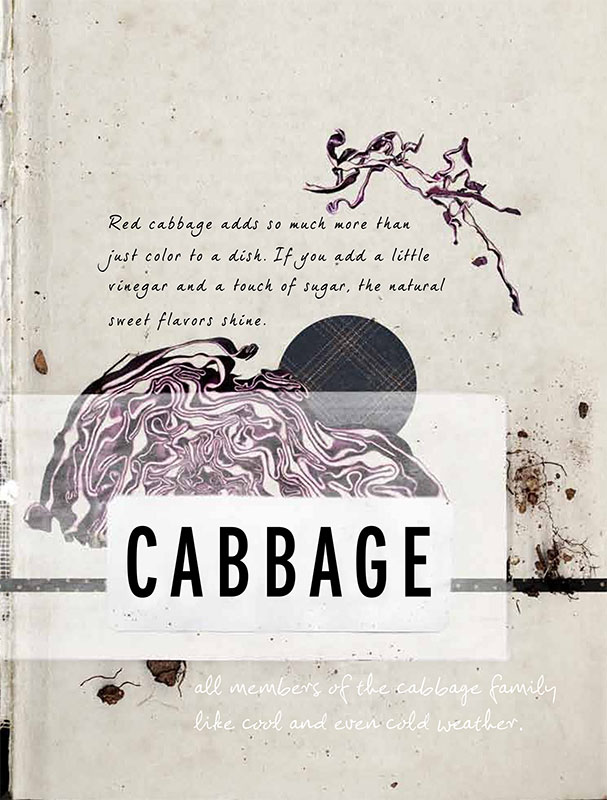
(BRASSICA OLERACEA VAR. CAPITATA)
Can’t stomach plain old white cabbage, because of the memories of the smell, off-putting color or texture of all the bad cabbage you have eaten before? Then it is time to put those prejudices aside and begin again. Just like its fair cousin the Brussels sprout, cabbage gets a bad rap when it truly is a delightful and delicate vegetable that is crying out to be respected and treated well.
RECIPES
TRUFFLED COLESLAW WITH GOLDEN SPICED QUAIL KIEV
SAUTÉED TUSCAN CABBAGE & MATSUTAKE MUSHROOM PASTA
SIMPLE BRAISED RED CABBAGE WITH CUMBERLAND SAUSAGES
Oh, cabbage. My first memory of cabbage is the short drive from Barnsley, in the UK, where we lived, to Darfield, where my aunty lived, every Sunday for lunch—Dad driving, Mum in the front and my elder sister, Lucy, and I in the back seat. We would pass a huge field on the left-hand side planted with cabbage and every time, without fail, Lucy would look over at that field, then lean in and whisper in my ear, “We found you in a box in that cabbage patch.” For years I actually thought my parents did find me in a cabbage patch! It used to upset me no end. Kids can be so cruel.
My Grandad Tom used to grow massive cabbages in his back garden, and it is a very popular and traditional English thing to find people cultivating cabbage in their allotments, which are small parcels of land that people lease from the local councils and they must be specifically used for growing food. They were introduced about 1,000 years ago, originally to compensate farmers who were forced from their lands by invasions and conquests, allowing them a subsistence living. Allotments today are hugely popular among people living in denser cities with no room for their own gardens. And in just about every single one, you will find cabbage growing. Perhaps this is a throwback to the time when growing your own food was really a matter of survival.
When you really look at it, cabbage is a staple of poorer economies the whole world over, and it plays a huge part in their national cuisine, particularly in the Eastern European bloc, where it is a cheap way to bulk out food. The Polish have their beautiful little traditional parcels of pierogi. The Germans ferment their cabbage and turn it into their famous Sauerkraut. And let’s not forget the cabbage leaves stuffed with ground meat and rice or barley held so dear by Czechs, Poles, Slovaks and Serbs alike. Cabbage abounds as beautiful, warm comfort food everywhere. Personally, coleslaw has my heart. I just love it. I can’t get enough of it.
There are so many varieties of cabbage, and different methods of serving it. As with Brussels sprouts, don’t let the fact that older generations absolutely abused this gorgeous vegetable put you off using it.
Don’t overlook white cabbage, or the finer Savoy. Just slice it as thin as you possibly can to reduce the cooking time. And if you reduce the cooking time, you will also reduce the amount of nutrients that you lose. I mean, by the time our nans had let the cabbage stew for three hours, besides being able to smell it from four doors away, nutritionally there was simply no point in eating it. All those lovely vitamins have gone down the sink with the cooking water. Simple braised cabbage is so easy, and just delicious. Just cook it quickly over high heat mixed with oil and butter and, as the juices leach out, add a dash of white wine or water. This will boil immediately and steam the cabbage at the same time as it’s sautéing in the pan. In about a minute, you will have a perfect side for a nice piece of pork.
But then there is red cabbage, which adds so much more than just eye-catching color to a dish. If you add a little bit of vinegar (a nice red wine or raspberry vinegar would be perfect for this type) and just a touch of sugar, the natural sweet flavors and moisture are drawn from the cabbage and really serve to lift the whole dish. Red cabbage is also amazing to pickle and preserve. You will get vast amounts even from one head of cabbage. I find that the nicest, sweetest leaves are just under the outer leaves that you need to peel back and remove. Once you get further in towards the center, the leaves tend to be woody, and I find these better for pickling.
And if you want something different, that will add beauty to your garden as well as your plate, go for Tuscan cabbage. This goes by a number of different names, including black cabbage, black kale and cavolo nero. It is all one and the same and just lovely. Treat it as you would Swiss chard. Shred it and eat it raw, the Italian way (it’s a revelation!), sauté it in a pan or add to a soup or braise in the last few minutes to wilt the leaves to add wonderful color and texture. The curly dark leaves are a gorgeous ornamental addition to your garden bed and are so easy to grow and use.
In fact, cabbage is fairly easy to grow in general. They do well in most soil, don’t need a lot of water and don’t mind a bit of cold or frost. The only down side is white cabbage is a large plant. It therefore requires a bit of space to produce a good head and they will take six months to mature from seed. So, if this is an issue for you, look to the Tuscan variety, which is much more compact and faster growing.
TRUFFLED COLESLAW WITH GOLDEN SPICED QUAIL KIEV
SERVES 4
Who doesn’t love chicken kiev? It’s a pub standard. I’ve used quail—a small chicken, really—but you can adapt this recipe and use chicken in exactly the same way. This dish comes with a warning: don’t wear your best dress or bow tie. Let the cooked quails cool a little because when you bite into them they have a tendency to shoot out their butter filling all over the place. (This may seem fun if you see it happen, but not fun when it gets you in the eye or on your nicest neighbor ever, who turns on his/her heels and leaves, then presents you with their dry-cleaning bill the next day … then proceeds to tell you that your fence is actually on their side of the plot. Believe me, this happens.)
This dish is great for kids and adults alike. The recipe is easier than it looks, I swear. It is all about the stages of preparation. Please remember to read through the recipe and ingredients to make sure you have everything prepared.
1 CUP UNSALTED BUTTER, SOFTENED
3½ OUNCES GARLIC, MINCED
6 BASIL LEAVES, CHOPPED
¼ BUNCH ITALIAN PARSLEY, LEAVES PICKED AND CHOPPED
FINE SEA SALT AND FRESHLY GROUND BLACK PEPPER
4 JUMBO QUAILS
2 TABLESPOONS CORIANDER SEEDS
1½ TABLESPOONS CUMIN SEEDS
1½ TABLESPOONS WHITE PEPPERCORNS
2 TEASPOONS MUSTARD SEEDS
2 TEASPOONS GROUND TURMERIC
2 TABLESPOONS GROUND GINGER
1 TABLESPOON SEA SALT
1 CUP ALL-PURPOSE FLOUR OR RICE FLOUR
1⅔ CUPS BUTTERMILK
¼ RED CABBAGE, FINELY SHREDDED
¼ SAVOY CABBAGE, FINELY SHREDDED
FINE SEA SALT AND FRESHLY GROUND BLACK PEPPER
1 SMALL CARROT, THINLY SLICED, THEN CUT INTO THIN STRIPS
½ LARGE RED ONION, THINLY SLICED
1 CUP MAYONNAISE
⅓ CUP TRUFFLE OIL
VEGETABLE OIL, FOR DEEP-FRYING
For the garlic butter, place all the ingredients in a mixing bowl and whip with a handheld beater until fully incorporated. Transfer to a piping (frosting) bag fitted with a small plain nozzle (about the size of a pea) and set aside at room temperature until ready to use.
For the spiced quails, debone each bird into breasts and legs (or if you and your butcher are close, I’m sure they’ll do it for you). For the breast pieces, remove the last two joints of the wings and French the remaining wing bone. Make a small insertion, using a small sharp knife, into the breast meat next to the wing but go as deep as you can—the more room the more butter you will be able to fit in. Pipe the garlic butter into the incision of each quail breast. Place the pieces of quail on a tray and refrigerate to firm up the butter.
For the leg pieces, remove the thigh bone leaving the leg bone intact. Pipe the butter into the leg bone cavity, fold over the meat on each side to enclose the butter and refrigerate to firm up the butter.
Gently toast all the spices in a dry skillet over low heat for about 4 minutes to release the natural oils. Place in a mortar and grind until the consistency of ground black pepper. Tip into a fairly large bowl, add the salt and flour and stir to combine. Place the buttermilk in another bowl. Take a piece of quail and dip it into the buttermilk, then into the spiced flour. Repeat this process again and place the piece of quail on a tray. Crumb the remaining pieces of quail. Place in the fridge until ready to cook.
For the truffled coleslaw, place both cabbages in a bowl, lightly salt and set aside for 5 minutes. Rinse the cabbage, then dry on a tea towel. Place in a large bowl, add the remaining ingredients and mix well. Set aside.
Preheat the oven to 375°F. If you have a deep-fryer, heat 6 cups of vegetable oil to 340°F and deep-fry the breast and leg pieces for 2 minutes or until nice and golden, then place in a roasting tray and finish cooking in the oven for 5 minutes. If you don’t have a deep-fryer, never mind, help is at hand. Pour 2 cups of vegetable oil into a deep saucepan (but not more than one-third full) over medium heat and heat to 340°F. Add the quail pieces and fry until nice and golden, then place in a roasting tray and finish cooking in the oven for 8 minutes. Serve straight away with some coleslaw on the side.
1 Prepare the garlic butter and debone the quail into breasts and legs.
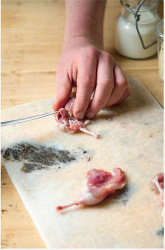
2 Using a sharp knife, make a small, deep insertion into the breast meat next to the wing. For the leg pieces, remove the thigh bone but leave the bone intact.
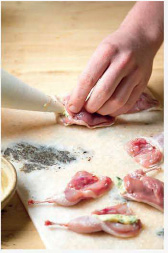
3 Pipe the garlic butter into the breast cavity.
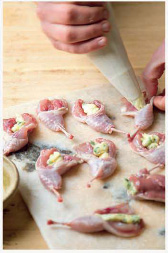
4 Continue to pipe the garlic butter into each of the quail pieces.
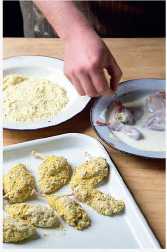
5 Dip quail pieces into buttermilk.
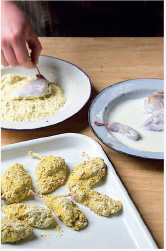
6 Coat each quail piece in spiced flour.
SAUTÉED TUSCAN CABBAGE & MATSUTAKE MUSHROOM PASTA
SERVES 4
This beautifully flavored and textured Tuscan cabbage sits stunningly with the wild flavored matsutake mushrooms. It’s one of my favorite autumnal dishes, enjoyed in front of the fire with a glass of red wine. But it does go well with a cheeky cider too.
14 OUNCES CRESTE DI GALLO PASTA (SEE NOTE) OR ANY THICK PASTA SHAPE
⅓ CUP OLIVE OIL
1 BUNCH TUSCAN CABBAGE (CAVOLO NERO), STALKS REMOVED, SHREDDED
10½ OUNCES MATSUTAKE MUSHROOMS, OR SAFFRON MILK CAPS, BRUSHED AND THICKLY SLICED
2 SHALLOTS, THINLY SLICED
2 GARLIC CLOVES, SLICED
3½ TABLESPOONS BUTTER, DICED
¾ CUP PASTA COOKING WATER
3 TABLESPOONS CHOPPED ITALIAN PARSLEY
JUICE OF 1 LEMON
SEA SALT AND FRESHLY GROUND BLACK PEPPER
FINELY GRATED PARMESAN, TO SERVE
Bring 6 cups of salted water to the boil. Add the pasta and cook for 7–9 minutes or until al dente. Take off the heat and allow the pasta to sit in the water.
Meanwhile, heat the olive oil in a large skillet over medium heat. Add the Tuscan cabbage and sauté until tender. Add the mushrooms, shallots, garlic and butter, turn down the heat and cook out for 4–5 minutes. Turn up the heat, add the pasta cooking water and stir to make an emulsion of sorts. Drain the pasta and add to the pan. Add the parsley and lemon juice, season with salt and pepper and divide among bowls. Finish with the grated Parmesan.
Note Creste di gallo pasta resembles the cockscomb on a chicken, hence its Italian name that means “chickens crown.” It is great for ragù-style pasta sauces as it soaks up the juices and adds texture to hearty dishes.
SIMPLE BRAISED RED CABBAGE WITH CUMBERLAND SAUSAGES
SERVES 4
This may just be one of the first recipes I ever made when working for Mike Taylor at Warren House just outside of London. My version here has been altered and played with but the base recipe came from one of the English queens of cookery Delia Smith. It’s just so simple and beautiful with all sorts of meat but who could go past the great English sausage, the Cumberland. (Although wherever you are from in England, you probably thin\your sausage is the best especially if you’re from Lincolnshire.)
1 STAR ANISE
1 JUNIPER BERRY
1 WHOLE CLOVE
1 CARDAMOM POD
½ CUP UNREFINED LIGHT BROWN SUGAR
½ SMALL RED CABBAGE, FINELY SHREDDED
2 LARGE WHITE ONIONS, SLICED
4 COOKING APPLES (SEE NOTES), PEELED AND DICED
⅓ CUP RED WINE VINEGAR
3½ TABLESPOONS BUTTER, DICED
SEA SALT AND FRESHLY GROUND BLACK PEPPER
4–8 CUMBERLAND SAUSAGES (SEE NOTES)
VEGETABLE OIL, FOR DRIZZLING
WHITE BREAD, TO SERVE
Ground the spices and sugar together using a mortar and pestle. Place the spice mixture, cabbage, onion, apple, vinegar and butter in a large saucepan over medium heat, season with salt and pepper and cook, stirring occasionally, for 45–60 minutes or until completely softened and moist.
Preheat the oven to 400°F. Place the sausages in a roasting tray, drizzle over some vegetable oil and roast for 12 minutes or until cooked.
Spoon the cabbage mixture into a large serving dish and top with the sausages. A few slices of good old white bread works wonders with this.
Notes I like to use Pippins for cooking with. Use a sharp non-cooking apple if these varieties aren’t available.
The size of Cumberland sausages varies from butcher to butcher. You should find them at your local butcher.